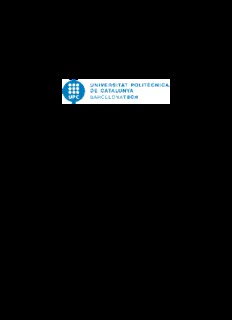Table Of ContentArtifact-centric Business Process Models in UML:
Specification and Reasoning
—PhDThesis—
ontserrat stanol
M E ˜
rof rnest eniente
AdvisedbyP . E T
March2016
AthesispresentedbyMontserratEstañol
inpartialfulfillmentoftherequirementsforthedegreeof
DoctorperlaUniversitatPolitècnicadeCatalunya.
Author: MontserratEstañol
Address: DepartmentofServiceandInformationSystemsEngineering
EdificiOmega,DespatxS206
JordiGirona,1–3
08034Barcelona,Spain
E-mail: [email protected]@gmail.com
Tomygrandmas
Acknowledgments
Thisthesiswouldnothavebeenpossiblewiththehelpandsupportof
manypeople.
To begin with, I would like to thank my advisor, Ernest Teniente.
I am very grateful for his guidance, rigor, support and encouragement
during all these years as his PhD student. Not only has he taught me
howtodoresearchandgivenmeinsightsonhisteachingmethods, but
hehasalsoshownmehisownwayofunderstandinglife. Ithasbeena
truly enriching experience, both academically and personally, and I feel
incrediblyhonoredandprivilegedforhavingbeenhisPhDStudent.
Secondly,IwouldalsoliketothankAnnaQueraltandMaria-Ribera
Sancho,fortheiradvice,helpandsupportduringtheearlystagesofthe
PhD.AndMariaalsotrustedmewithherstudents,givingmethechance
toteachinoneofhercourses. AspecialthanksalsogoestoAntoniOlivé,
whoactuallygavemethefirstopportunitytoteachaclassatuniversity.
A big thank you as well to all the people, mainly researchers, I’ve
hadthepleasuretoworkwithduringtheseyears: JosepCarmona,Jorge
Muñoz, Diego Calvanese, Marco Montali, Sylvia Díaz-Montenegro and
ManuelCastro.
Iwouldalsoliketothankmycolleaguesinboththeresearchgroup
andtheofficefortheirsupportandfortheirhelpwheneverIasked. My
gratitude also goes to the anonymous reviewers, whose insightful com-
mentsallowedmetoseesomeaspectsofthisthesisinadifferentlightand
helpedmetoimproveitinwayswhichwouldnothaveoccurredtome.
Iamalsoverygratefultomyfamilyandfriends,fortheirsupportand
encouragementduringallthistime. Inparticular, Iwouldliketothank
myparents,especiallymymother,forencouragingmetostudyandwork
hard. Togetherwithmyaunt,theyhavebeenaconstantsourceofsupport
andhavealwaysbeenreadytolendanear.
AspecialthanksgotoManel,whoencouragedmefromtheverystart
tobeginthePhDjourney. IfithadnotbeenforhimIwouldnotbewriting
thistoday. Hehasalwaysgivenmehisunwaveringsupportandhasbeen
therewhenIneededhim. Andhisknowledgeofprogrammingandgood
practiceshasprovedveryusefulwheneverIhadquestions. Thanksfor
everything.
Finally,Iwouldliketodedicatethisthesistomygrandmas. Neitherof
themhadeasyaccesstoeducationaschildrenandhadtheyownshareof
difficulties,includingsurvivingawar. Unfortunately,oneofthempassed
away before seeing this work completed, although I believe she would
havelovedtoseeit. Ithasbeenthroughtheirefforts,andthoseofmany
otherpeople,includingmyparents,thatI’vehadamucheasierlife.Thank
you.
The work presented here has been partly supported by Universitat Politèc-
nica de Catalunya - Barcelona Tech, the Spanish Ministerio de Ciencia e In-
novaciónunderprojectTIN2011-24747,theSpanishMinisteriodeEconomíay
CompetitividadunderprojectTIN2014-52938-C2-2-RandbytheCatalanagency
AGAURunderproject2014SGR1534.
Abstract
Businessprocessesaredirectlyinvolvedintheachievementofanor-
ganization’s goals, and for this reason they should be performed in the
bestpossibleway.Modelingbusinessprocessescanhelptoachievethisas,
forinstance,modelscanfacilitatethecommunicationbetweenthepeople
involvedintheprocess,theyprovideabasisforprocessimprovementand
theycanhelpperformprocessmanagement.
Processes can be modeled from many different perspectives. Tra-
ditional process modeling has followed the process-centric (or activity-
centric)perspective,wherethefocusisonthesequencingofactivities(i.e.
thecontrolflow),largelyignoringorunderspecifyingthedatarequiredby
thesetasks.
In contrast, the artifact-centric (or data-centric) approach to process
modelingfocusesondefiningthedatarequiredbythetasksandthedetails
ofthetasksthemselvesintermsofthechangestheymaketothedata. The
BALSAframeworkdefinesfourdimensionswhichshouldberepresented
inanyartifact-centricbusinessprocessmodel:businessartifacts,lifecycle,
services(i.e. tasks)andassociations. Usingdifferenttypesofmodelsto
representthesedimensionswillresultindistinctrepresentations,whose
differingcharacteristics(e.g. thedegreeofformalityorunderstandability)
willmakethemmoreappropriateforonepurposeoranother.
Consideringthis,inthefirstpartofthisthesisweproposeaframework,
BAUML, for modeling business processes following an artifact-centric
perspective.ThisframeworkisbasedonusingacombinationofUMLand
OCLmodels,anditsgoalistohaveafinalrepresentationoftheprocess
whichisbothunderstandableandformal,toavoidambiguitiesanderrors.
However, once a process model has been defined, it is important to
ensureitsquality.Thiswillavoidthepropagationoferrorstotheprocess’s
implementation. Although there are many different quality criteria, we
focusonthesemanticcorrectnessofthemodel,answeringquestionssuch
asdoesitrepresentrealitycorrectly? orarethereanyerrorsandcontradictions
init?.
Therefore, the second part of this thesis is concerned with finding a
way to determine the semantic correctness of our BAUML models. We
are interested in considering the BAUML model as a whole, including
the meaningof thetasks. To doso, we firsttranslate ourmodels intoa
well-knownframework,aDCDS(Data-centricDynamicSystem)towhich
thenmodel-checkingtechniquescanbeapplied. However,DCDSshave
beendefinedtheoreticallyandthereisnotoolthatimplementsthem.
For this reason, we also created a prototype tool, AuRUS-BAUML,
whichisabletotranslateourBAUMLmodelsintologicandtoreasonon
their semantic correctness using an existing tool, SVTe. The integration
betweenAuRUS-BAUMLandSVTeistransparenttotheuser. Logically,
the thesis also presents the logic translation which is performed by the
tool.
Description:BAUML, for modeling business processes following an artifact-centric perspective. This framework is based on using a combination of UML and.

